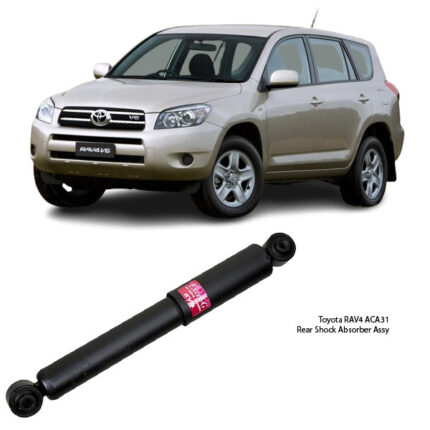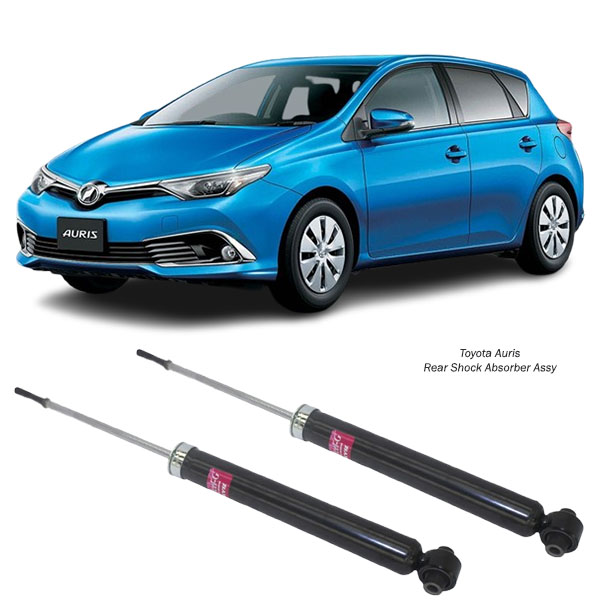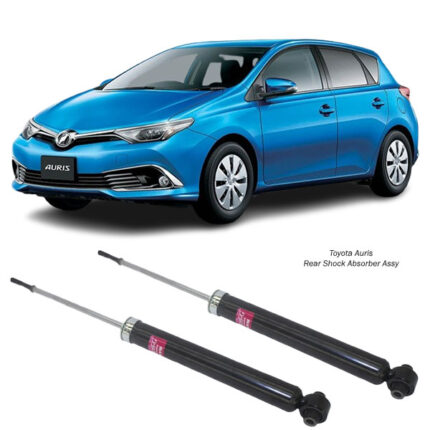Get Toyota Auris Rear Shock Absorber Assy 349035 in Kenya
A rear shock absorber assembly is a key component of a vehicle’s suspension system. It helps absorb shocks from road irregularities, ensuring a smooth and stable ride. Without it, driving would be uncomfortable, and vehicle handling would be unsafe.
Why is it Important?
- Reduces impact from road bumps and potholes.
- Enhances vehicle stability and control.
- Extends the lifespan of other suspension components.
- Improves ride comfort for passengers.
2. Components of a Rear Shock Absorber Assembly
A rear shock absorber assembly consists of several parts that work together to dampen vibrations and shocks.
1. Shock Absorber (Damper)
The main component that controls movement and absorbs shocks. It converts kinetic energy into heat, which is then dissipated.
2. Coil Spring (In Some Cases)
If it’s a coilover shock absorber, it includes a coil spring that supports the vehicle’s weight and provides additional damping.
3. Mounting Hardware
Bolts, bushings, and brackets secure the shock absorber to the vehicle frame and suspension arms.
4. Piston & Cylinder Mechanism
Inside the shock absorber, a piston moves through hydraulic fluid or gas, creating resistance and damping vibrations.
3. Types of Rear Shock Absorbers
Different vehicles require different shock absorber designs. Let’s explore the common types.
1. Twin-Tube Shock Absorbers
- Most commonly used in passenger vehicles.
- Contains an inner working tube and an outer reservoir tube.
- Uses hydraulic fluid to absorb shocks.
- Affordable and reliable.
2. Mono-Tube Shock Absorbers
- More advanced and responsive than twin-tube shocks.
- Uses a single cylinder filled with gas and oil.
- Better cooling and heat dissipation.
- Often found in performance and off-road vehicles.
3. Gas-Charged Shock Absorbers
- Uses nitrogen gas to prevent foaming of the hydraulic fluid.
- Reduces shock fade in extreme driving conditions.
- Provides a firmer and more controlled ride.
4. Coilover Shock Absorbers
- Includes both a shock absorber and a coil spring in one unit.
- Adjustable ride height and damping settings.
- Commonly used in sports and racing cars.
5. Air Shock Absorbers
- Uses air pressure instead of a metal spring.
- Can be adjusted for different load conditions.
- Found in high-end luxury vehicles and trucks.
4. How Does a Rear Shock Absorber Work?
Step 1: Compression
When the wheel hits a bump, the shock absorber compresses, forcing hydraulic fluid through small valves inside the piston. This controls the speed at which the suspension compresses.
Step 2: Damping
The fluid flow slows down movement, reducing vibrations and oscillations.
Step 3: Rebound
Once the shock is compressed, it expands back to its original position, ensuring the wheel stays in contact with the road.
5. Signs of a Failing Rear Shock Absorber
Over time, shock absorbers wear out, leading to poor ride quality and handling issues. Look out for these signs:
1. Excessive Bouncing
If your car bounces too much after hitting a bump, the shocks might be worn out.
2. Uneven Tire Wear
Worn shocks can cause tires to wear unevenly, reducing their lifespan.
3. Poor Handling & Stability
Difficulty controlling the vehicle, especially during turns or braking, is a warning sign.
4. Leaking Hydraulic Fluid
Visible fluid leaks on the shock absorber indicate internal damage.
5. Nose Diving & Rear Squatting
- Nose Diving: Front end dips when braking.
- Rear Squatting: Back end lowers excessively during acceleration.
6. How to Maintain Your Rear Shock Absorbers
Proper maintenance ensures your shock absorbers last longer and perform efficiently.
1. Regular Inspections
Check for leaks, corrosion, and damage every 10,000 – 15,000 miles.
2. Replace When Necessary
Most shock absorbers last 50,000 – 100,000 miles, but replace them sooner if signs of wear appear.
3. Avoid Overloading
Excessive weight can put additional strain on the shocks, reducing their lifespan.
4. Drive Carefully
Avoid potholes and rough terrain to prevent premature wear.
7. How to Replace a Rear Shock Absorber
Replacing a rear shock absorber is a moderate-level DIY task. Here’s a step-by-step guide:
Tools Needed
Jack & Jack Stands
Wrench Set
Socket Set
New Shock Absorbers
Torque Wrench
Steps to Replace
Lift the Vehicle using a jack and secure it with jack stands.
Remove the Wheel to access the shock absorber.
Unbolt the Old Shock Absorber from the suspension and chassis.
Install the New Shock Absorber and tighten the bolts to manufacturer specifications.
Reattach the Wheel and lower the vehicle.
Test Drive to ensure everything functions properly.
Tip: Always replace shocks in pairs (both rear shocks) for even performance.
Follow us on Facebook for more parts.




